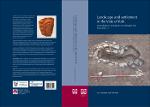Landscape and Settlement in the Vale of York
Archaeological investigations at Heslington East, York, 2003–13
| dc.contributor.author | Roskams, Steve | |
| dc.contributor.author | Neal, Cath | |
| dc.date.accessioned | 2020-07-09T13:14:52Z | |
| dc.date.available | 2020-07-09T13:14:52Z | |
| dc.date.issued | 2020 | |
| dc.identifier.uri | https://library.oapen.org/handle/20.500.12657/39942 | |
| dc.description.abstract | The Vale of York, in North Yorkshire, has been used and shaped by communities since the end of the last Ice Age to the modern day. Its earliest, prehistoric features chart the way in which household groups shifted from mobile to more sedentary forms of occupation over time, culminating in the creation of landscape divisions from the end of the Bronze Age, and then recognisable field systems during the Iron Age. Throughout all periods, a variety of activity types on the landscape has been evident in the landscape, taking significantly different forms in different contexts: water management; the creation of boundaries; agricultural production; structural development, from domestic houses to larger monuments; exchange and consumption; and mortuary practices plus other ritual activity. This volume takes a thematic approach to these activities, revealing much about the area's development. Providing a thematic analysis of the excavated evidence from the Heslington East area, this volume combines the results of commercial, student training and local community fieldwork between 2007 and 2013. A concluding chapter discusses temporal change by looking at key points of transition in landscape activity in the area and interpreting one of the largest exposures of prehistoric and Roman activity in the immediate hinterland of Eboracum, a major Roman town in Britain. | en_US |
| dc.language | English | en_US |
| dc.relation.ispartofseries | Reports of the Research Committee of the Society of Antiquaries of London | en_US |
| dc.subject.classification | thema EDItEUR::N History and Archaeology::NK Archaeology::NKL Landscape archaeology | en_US |
| dc.subject.classification | thema EDItEUR::N History and Archaeology::NK Archaeology::NKD Archaeology by period / region | en_US |
| dc.subject.classification | thema EDItEUR::3 Time period qualifiers::3B Prehistory | en_US |
| dc.subject.classification | thema EDItEUR::1 Place qualifiers::1Q Other geographical groupings: Oceans and seas, historical, political etc::1QB Historical states, empires, territories and regions::1QBA Ancient World | en_US |
| dc.subject.classification | thema EDItEUR::1 Place qualifiers::1D Europe | en_US |
| dc.subject.classification | thema EDItEUR::3 Time period qualifiers::3K CE period up to c 1500::3KL c 1000 CE to c 1500 | en_US |
| dc.subject.other | excavation | en_US |
| dc.subject.other | archaeology | en_US |
| dc.subject.other | geophysical survey | en_US |
| dc.subject.other | landscape history | en_US |
| dc.subject.other | field systems | en_US |
| dc.title | Landscape and Settlement in the Vale of York | en_US |
| dc.title.alternative | Archaeological investigations at Heslington East, York, 2003–13 | en_US |
| dc.type | book | |
| oapen.abstract.otherlanguage | Ce volume décrit les résultats d’un long projet de secours qui a eu lieu dans la vallée de York, North Yorkshire, juste avant un agrandissement d’une université située à Heslington East, au sud-est de la ville de York. Ce projet constitue la plus grande exposition d’activité préhistorique et romaine, examiné d’une façon archéologique, dans l’arrière-pays immédiat de York. En unifiant le travail des organisations commerciales, des étudiants en formation, et des bénévoles de la communauté locale, on illustre le développement complexe de ce paysage, au moins depuis la période néolithique, mais surtout de l’âge de fer, la période romaine et moderne. Ce développement est décrit par rapport à une série de genres d’engagement humain, plutôt qu’un format chronologique. Dieser Band beschreibt die Ergebnisse eines langfristigen Rettungsprojekts im Vale of York, Grafschaft North Yorkshire, das vor der Erweiterung der Universität in Heslington East im Südosten der Stadt York stattfand. Bei dem Projekt handelt es sich um die größte Freilegung prähistorischer und römischer Aktivitäten, die bislang im unmittelbaren Hinterland von York archäologisch untersucht wurden. Durch die Kombination der Arbeitsergebnisse kommerzieller Organisationen, der Ausbildung von Studenten und Freiwilligen aus den umliegenden Gemeinden können wir die komplexe Entwicklung der Landschaft vor Ort zumindest seit der Jungsteinzeit, am intensivsten jedoch in der Vorrömischen Eisenzeit, der Römischen Kaiserzeit und der Neuzeit aufzeigen. Anstelle einer Zeitperioden-basierten Gliederung wird diese Entwicklung anhand einer Reihe von Kategorien menschlicher Tätigkeiten diskutiert. | en_US |
| oapen.identifier.doi | 10.26530/20.500.12657/39942 | |
| oapen.relation.isPublishedBy | d42419c2-5275-411b-8855-aed87bed3f71 | en_US |
| oapen.relation.isFundedBy | b595d8a6-5902-4cd3-81e0-7f8a843479ac | en_US |
| oapen.series.number | LXXXII | en_US |
| oapen.pages | 192 | en_US |
| oapen.place.publication | London | en_US |
| oapen.remark.public | Funder name: Heritage Lottery Fund |

